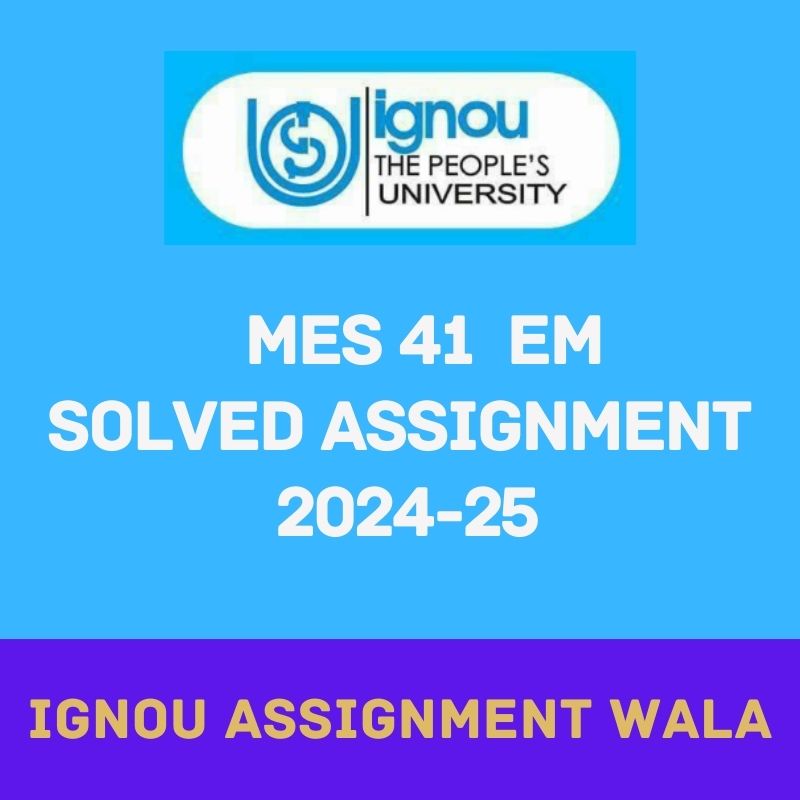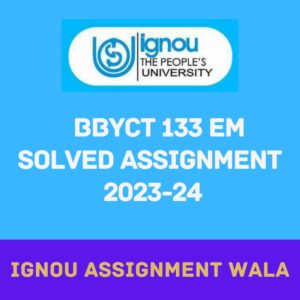IGNOU MES 41 PGDEMA SOLVED ASSIGNMENT 2024-25 (PGDEMA)
Assignments- January & July 2024
MES-041
GROWTH AND DEVELOPMENT OF EDUCATIONAL MANAGEMENT
Answer the following questions in about 500 words each:
1. Discuss the issues confronting school education in India.
Title: Challenges Confronting School Education in India
Introduction:
School education in India faces numerous challenges that impede the holistic development of students and hinder the education system’s effectiveness. Despite significant progress in enrollment rates, the quality of education, infrastructure, and the socio-economic divide pose substantial hurdles. This essay delves into some of the critical issues confronting school education in India.
1. Quality of Education:
One of the foremost challenges in the Indian education system is the varying quality of education across different states and regions. Disparities exist in the curriculum, teaching methodologies, and evaluation processes. The focus often remains on rote learning, neglecting critical thinking and practical application of knowledge. The lack of quality assurance mechanisms leads to a wide gap in the academic standards between urban and rural areas.
2. Infrastructure Deficit:
Inadequate infrastructure is a significant hurdle in providing quality education. Many schools lack basic amenities such as proper classrooms, libraries, laboratories, and sanitation facilities. This not only affects the learning environment but also poses health and safety risks for students. Infrastructure development must be a priority to ensure that students have access to a conducive learning environment.
3. Teacher Shortage and Quality:
The shortage of qualified and motivated teachers is a persistent issue in the Indian education system. In remote and rural areas, schools often struggle to attract and retain competent teachers. Additionally, the quality of teacher training programs varies, impacting the educators’ ability to deliver effective lessons. Regular professional development opportunities for teachers and competitive compensation can help address these issues.
4. Socio-Economic Disparities:
Socio-economic disparities play a significant role in determining educational outcomes. Children from economically disadvantaged backgrounds face challenges such as inadequate nutrition, lack of access to learning resources, and pressure to contribute to family income. Bridging this gap requires targeted interventions, including scholarship programs, nutritional support, and community outreach initiatives.
5. Outdated Curriculum:
The curriculum in many Indian schools is often outdated, emphasizing theoretical knowledge over practical skills. A more dynamic and industry-relevant curriculum is essential to prepare students for the rapidly evolving job market. Integrating technology and vocational education can enhance the curriculum’s relevance and equip students with the skills required in the 21st-century workforce.
6. Examination Pressure:
The prevalent examination-centric education system in India puts undue pressure on students. The focus on rote memorization to excel in exams leaves little room for creativity and critical thinking. This approach hampers the development of a holistic understanding of subjects and discourages independent thought. A shift towards continuous assessment and project-based evaluation can help alleviate this pressure.
7. Access to Education:
While there has been a substantial increase in enrollment rates, ensuring universal access to education remains a challenge. Many children, especially girls in certain regions, still face barriers to attending school due to factors such as distance, cultural norms, and socio-economic constraints. Government initiatives and community awareness programs are crucial for promoting inclusivity in education.
8. Technological Divide:
The digital divide exacerbates educational inequalities in India. While urban schools may have access to modern technology, many rural schools lack even basic technological infrastructure. Bridging this technological gap is vital for ensuring that all students have equal opportunities to access educational resources and stay abreast of advancements in information technology.
Conclusion:
Addressing the challenges confronting school education in India requires a comprehensive and multifaceted approach. Policymakers, educators, and communities must collaborate to implement reforms that focus on improving the quality of education, addressing infrastructure deficits, ensuring teacher quality, and promoting inclusivity. By tackling these issues, India can work towards fostering an education system that empowers students to meet the demands of the future and contribute meaningfully to society.
2. Compare the educational management in pre- and post-independent India.
Title: Evolution of Educational Management in Pre- and Post-Independent India
Introduction:
The educational landscape in India has undergone significant transformations, with a notable shift in educational management approaches before and after gaining independence in 1947. This essay aims to compare the educational management in pre- and post-independent India, highlighting the key changes, challenges, and achievements during these distinct periods.
Educational Management in Pre-Independent India:
1. Colonial Influence:
– During the pre-independence era, India was under British colonial rule, and the education system reflected the imperialistic agenda.
– The educational management was centralized and focused on producing a workforce to serve the British interests, with limited emphasis on holistic development or local needs.
2. Social Disparities:
– The education system was marked by social disparities, with access to quality education restricted to the elite class. The majority of the population, especially in rural areas, had limited or no access to formal education.
– The educational management system perpetuated social inequalities, leading to a divided society with limited opportunities for upward mobility.
3. Curricular Imbalance:
– The curriculum was Eurocentric, with little relevance to the cultural and historical context of India. The focus was on English language and literature, neglecting regional languages and indigenous knowledge systems.
– Vocational and practical aspects of education were often overlooked, hindering the development of skills needed for self-sufficiency and community development.
4. Limited Autonomy:
– Educational institutions had limited autonomy, and decisions were predominantly made by the colonial administration. This lack of local control hindered the responsiveness of the education system to the needs of the diverse Indian population.
Educational Management in Post-Independent India:
1. Policy Reforms:
– After gaining independence, India underwent significant policy changes in education. The government aimed to address the historical inequities and transform the education system into a tool for social justice and nation-building.
– The Kothari Commission (1964-66) was instrumental in shaping educational policies, emphasizing universal access, equality, and quality education for all.
2. Expansion of Access:
– Post-independence, there was a concerted effort to expand access to education. Initiatives such as the Sarva Shiksha Abhiyan and the Right to Education Act aimed to ensure free and compulsory education for children up to the age of 14, fostering inclusivity.
3. Diversification of Curriculum:
– Efforts were made to diversify the curriculum, incorporating regional languages, cultural studies, and vocational education. This shift aimed to make education more relevant to the diverse needs and aspirations of the Indian population.
4. Empowerment of Local Institutions:
– The post-independence period witnessed an attempt to empower local educational institutions. Decentralization and the establishment of bodies like the School Management Committees aimed to involve local communities in decision-making processes.
5. Challenges in Implementation:
– Despite the progressive policies, challenges such as inadequate infrastructure, teacher shortages, and quality disparities persisted. The rapid increase in enrollment led to concerns about the capacity of the system to provide quality education.
6. Technology Integration:
– In the post-independence era, there was a gradual integration of technology in education. This included the use of multimedia tools, e-learning platforms, and digital resources, aiming to enhance the quality of education and reach a wider audience.
Conclusion:
The evolution of educational management in India from pre-independence to the post-independent era reflects a journey marked by significant shifts in policies, ideologies, and approaches. While the post-independence period has seen commendable efforts to address historical inequalities and expand access to education, challenges in implementation and quality persist. The ongoing need for reforms, adaptation to changing global trends, and a focus on inclusivity remain key considerations for shaping the future of educational management in India.
3. Explain, with examples, as to how ICT can be used for effective and efficient
educational management.
Information and Communication Technology (ICT) has transformed various aspects of our lives, including education. In the realm of educational management, ICT plays a crucial role in enhancing efficiency, accessibility, and overall effectiveness. This essay will explore the ways in which ICT can be harnessed for effective educational management, supported by examples.
1. Student Information Systems (SIS):
– *Definition:* SIS is a comprehensive tool that manages student-related data, including attendance, grades, and personal information.
– *Example:* A school adopts an integrated SIS that allows teachers to input grades online, facilitates automated attendance tracking, and provides instant access to student records. This helps in quick decision-making and improves overall academic monitoring.
2. Learning Management Systems (LMS):
– *Definition:* LMS is a digital platform that enables the administration, documentation, tracking, reporting, and delivery of educational courses or training programs.
– *Example:* A university implements an LMS to conduct virtual classes, share course materials, and assess students through online quizzes and assignments. This fosters a flexible learning environment and enables efficient management of course content.
3. Communication Platforms:
– *Definition:* ICT facilitates communication among stakeholders, including teachers, students, and parents, through various platforms such as emails, messaging apps, and forums.
– *Example:* A school adopts a communication app that allows teachers to share updates, assignments, and grades with parents in real-time. This enhances parental involvement and ensures effective communication channels between all parties.
4. Data Analytics for Decision-Making:
– *Definition:* ICT tools can process and analyze vast amounts of data to derive actionable insights, aiding decision-making processes.
– *Example:* A school employs data analytics to assess student performance trends, identify areas for improvement, and optimize teaching strategies. This data-driven approach helps in making informed decisions to enhance the overall quality of education.
5. Virtual Classrooms and E-Learning:
– *Definition:* Virtual classrooms leverage ICT to provide education remotely, allowing students to access learning materials and interact with teachers online.
– *Example:* In response to the COVID-19 pandemic, many educational institutions worldwide adopted virtual classrooms. Teachers conduct live classes, share multimedia resources, and engage students through online discussions, ensuring continuity in education.
6. Digital Resource Management:
– *Definition:* ICT enables the efficient organization, storage, and retrieval of educational resources such as e-books, videos, and interactive simulations.
– *Example:* A school implements a digital library system where teachers can upload and share resources. Students can access these materials anytime, fostering self-directed learning and reducing dependency on physical textbooks.
7. Online Assessment Tools:
– *Definition:* ICT provides platforms for creating, administering, and grading assessments electronically.
– *Example:* Teachers use online assessment tools to create quizzes, exams, and assignments. These tools automate grading, provide instant feedback to students, and generate comprehensive performance reports, saving time and ensuring fairness in evaluation.
8. Financial Management Systems:
– *Definition:* ICT streamlines financial processes, including budgeting, invoicing, and expense tracking, contributing to efficient resource allocation.
– *Example:* A school adopts a financial management system that automates fee collection, tracks expenditures, and generates financial reports. This ensures transparency, reduces administrative workload, and enables effective financial planning.
9. Professional Development through Online Platforms:
– *Definition:* ICT facilitates continuous professional development for educators through online courses, webinars, and collaborative platforms.
– *Example:* Teachers engage in online workshops and courses to enhance their teaching skills. Virtual collaboration platforms enable them to share best practices, resources, and insights, fostering a culture of continuous improvement among educators.
In conclusion, the effective use of ICT in educational management transforms traditional systems, making them more efficient, accessible, and responsive to the needs of students, teachers, and administrators. The examples provided illustrate how ICT tools contribute to streamlined processes, data-driven decision-making, and the overall enhancement of the educational experience. As technology continues to evolve, it is imperative for educational institutions to leverage ICT to adapt and thrive in the dynamic landscape of education.





